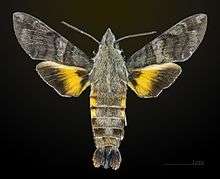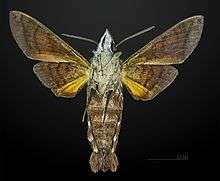Macroglossum belis
| Common hummingbird hawkmoth | |
|---|---|
 | |
| Macroglossum belis Dorsal MHNT | |
 | |
| Macroglossum belis Ventral MHNT | |
| Scientific classification | |
| Kingdom: | Animalia |
| Phylum: | Arthropoda |
| Class: | Insecta |
| Order: | Lepidoptera |
| Family: | Sphingidae |
| Genus: | Macroglossum |
| Species: | M. belis |
| Binomial name | |
| Macroglossum belis (Linnaeus, 1758)[1] | |
| Synonyms | |
| |
Macroglossum belis (common hummingbird hawkmoth) is a moth of the family Sphingidae. It is known from Sri Lanka, India, Nepal, Thailand, southern China, Taiwan, Japan (Ryukyu Archipelago), Vietnam and Indonesia (Java).[2]
Description
The wingspan is 50–60 mm. Adults are attracted to the flowers of Duranta erecta and Lantana camara at dawn and dusk. Adult differs from M. affictitia in the head, thorax, abdomen and fore wings being redder brown, the two lines forming the antemedial band of the fore wing not filled in with black. The postmedial lines not so parallel, the second line being nearer the first at the costa, the third at inner margin. The patch near the apex reddish brown with no dark streak below it. Hind wings with reddish yellow band.[3]
Larva is black in color. The head red, a white subdorsal line and the sides spotted and streaked with red and yellow. Larvae have been recorded feeding on Strychnos angustiflora in Hong Kong and on Strychnos nux-vomica, Saprosoma indicum and Spermadictyon suaveolans in India.[4]
References
- ↑ "CATE Creating a Taxonomic eScience - Sphingidae". Cate-sphingidae.org. Archived from the original on 2012-09-26. Retrieved 2011-10-25.
- ↑ "Macroglossum belis Linnaeus, 1776". India Biodiversity. Retrieved 6 July 2016.
- ↑ Hampson G. F. (1892). "The Fauna Of British India Including Ceylon And Burma Moths Vol-i". Digital Library of India. p. 558. Retrieved 4 July 2016.
- ↑ Pittaway AR; Kitching I. "Sphingidae of the Eastern Palaearctic". Tpittaway.tripod.com. Retrieved 2011-10-25.